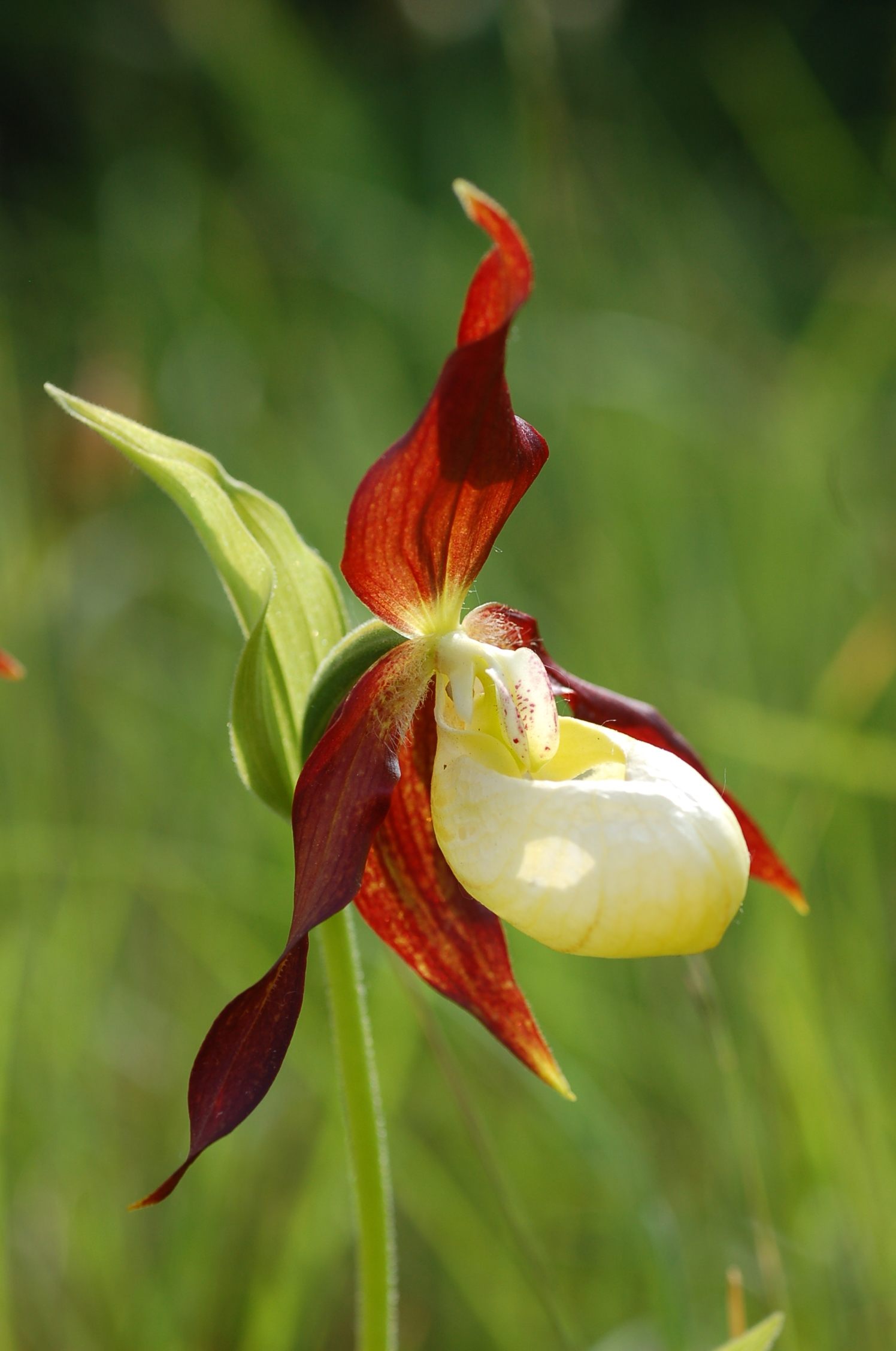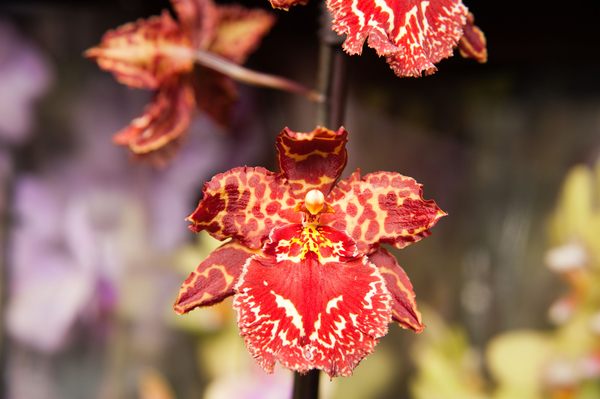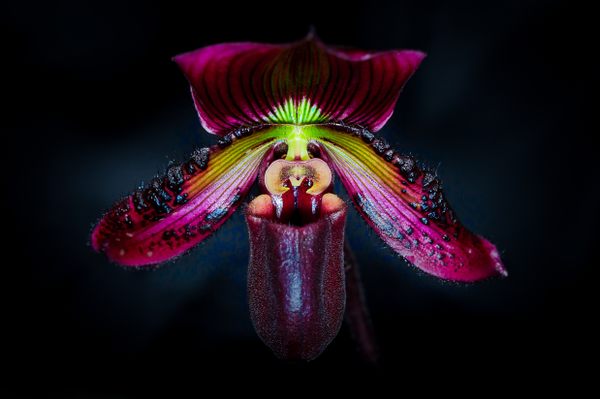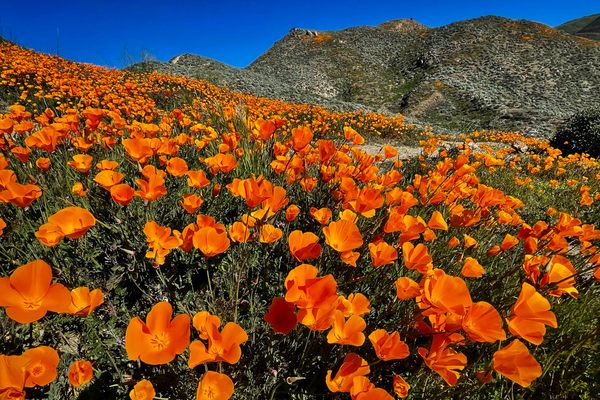This British Orchid Is Under Guard in a Secret Location
The last wild lady’s slipper in the U.K. is a target for thieves.
For a few weeks each spring, a lone guard monitors the moors of northern England. This warden pitches a tent in a remote field to watch over a prize so rare that collectors have been known to break laws, trek into deep jungles, and risk capture by guerillas in its pursuit. The object? A single lady’s slipper orchid, Cypripedium calceolus—the last wild plant of its kind left in the United Kingdom.
If you saw the lady’s slipper’s delicate crimson-and-yellow petals tremble in a spring breeze, you too may understand the allure that has gripped collectors for generations. The love of orchids, labelled “orchidelirium” by the Victorians, erupted in the 19th century, as the reach of the British Empire enabled the import of a few of these delicate flowers to the U.K. While supermarkets now sell inexpensive orchids, the flowers’ finicky reproductive process—most of them are slow-growing, with seeds that depend on a symbiotic relationship with a naturally occurring fungus—means that scientists have only managed to adapt a relative few species for mass greenhouse cultivation. The vast majority of the world’s more than 28,000 orchid species remain elusive to most purchasers, and that, says Richard Thomas, Communications Coordinator at TRAFFIC, an NGO monitoring wildlife trade, only amplifies their appeal.

That’s bad news for orchids, which are exquisitely adapted to their environments. Some species grow only within highly localized microclimates, on a single mountaintop or a specific rainforest tree. Even orchids with wider ranges are highly sensitive to environmental changes caused by development, climate change, or over-collection. Of the 98,500 species included on the Red List of Threatened Species produced by the International Union for Conservation of Nature, 1,360 listings are orchids.
Britain’s Cypripedium calceolus faces a unique dilemma. Compared to other species, this lady’s slipper has a wide range, growing from the U.K. to Russia, and in some parts of Asia. Because it remains relatively abundant in the wilderness of countries such as Sweden, the Red List considers Cypripedium calceolus a species of least concern for conservation in Europe. Zoom into the U.K., though, and the picture changes. Thanks to Victorian orchidelirium, Britain’s lady’s slipper population was decimated by ruthless collection. By the early-20 century, it was believed to be extinct. That is, until 1930, when a lone, nature-loving wanderer stumbled upon one in Yorkshire. Typical of some orchids’ very long lifespans, the plant grows to this day.*

Ask Mike Fay, Senior Research Leader at the Royal Botanic Gardens at Kew, about this Cypripedium calceolus and he will happily tell you about its rediscovery, the kind of soil it prefers, and his lab’s effort to propagate it. He will not, however, tell you its location. “That isn’t in the public domain,” he says.
Originally, the flower’s location was known only to a few botanists, who were more committed to restoring the species than to acquiring it. As with all things forbidden, however, word of the flower spread. Eventually, government conservationists became so worried about orchid poachers that they swore to keep its location a strict secret—not even all the orchid experts at Kew Gardens knows where it is. The plant itself is zealously protected as well. For a few weeks each spring, the flower’s delicate blooms receive round-the-clock guard. Tasked with the job of collecting data on the flower’s soil conditions, the weather, and the progress of its blossoming, the guard is the first line of defense between the lady’s slipper and its would-be captors.

Orchid thieves have targeted British lady’s slippers before. Cypripedium calceolus is protected under the U.K.’s Wildlife and Countryside Act of 1981, and stealing or trading it is punishable by fines and prison time. As part of a program to restore the species, researchers at Kew Gardens have been propagating the lady’s slipper from cultivated specimens with known wild origins.** They’ve managed to successfully reintroduce plants in up to a dozen sites across Britain. In 2018, the reintroduced plants produced a total of 700 shoots and 200 blooms.
Yet they, too, are under threat. Besides metal cages and copper rings installed to ward off grazing deer and hungry slugs, the reintroduced flowers have periodically been granted police protection. In 2004, a thief attempted to pull one of these reintroduced plants up by the root; it was found mangled, though it survived. In 2009, the same plant, located on a golf course in Lancashire, survived a knife attack by a poacher looking to collect a slice. In 2010, public officials were so worried about this oft-attacked specimen that they granted it temporary police protection. Another reintroduced lady’s slipper was accompanied to the 2013 Chelsea Flower Show by its own personal phalanx of guards.

To quench the lust for lady’s slippers, conservationists have resorted to an age-old plot: a honey trap. “These are what we call honeypot sites,” Fay says. “We want people to see the species in the wild and enjoy it.” Conservationists have opened two honeypot locations with reintroduced lady’s slippers: Kilnsey Park Estate in Yorkshire and Gait Barrows in Lancashire. In spring, says Thomas, the line to see rare orchids can be hundreds deep.
Still, some obsessives aren’t satisfied with just a taste of orchid honey—they want to own the whole jar. That’s why conservationists insist on safeguards like the last wild lady’s slipper’s warden. Despite the extensive protections afforded to the plants worldwide, orchidelirium continues to drive collectors to extremes. A few years ago, says Fay, a newly discovered Vietnamese orchid species was available on the illicit U.S. market before any trade permits were legally given in Vietnam. Scientists are already concerned about the species’ survival.

How to understand a passion that kills what it loves? For Thomas of TRAFFIC, the lust is mysterious. We may as well ask about the meaning of life, he says. But Fay has a simple explanation. “They lose the sense of how important it is for these things to continue existing,” he says of collectors. “They just want to have it.”
*Correction: A previous version of the article stated that all orchids have long lifespans. In fact, orchid lifespans vary widely.
**Correction: A previous version of the article stated that the specimens were grown in a greenhouse. In fact, the propagated plants are grown outside.
***Correction: A previous version of the article misidentified the genus of an orchid in a caption as Phalaenopsis. It is actually an Oncidium hybrid.



















Follow us on Twitter to get the latest on the world's hidden wonders.
Like us on Facebook to get the latest on the world's hidden wonders.
Follow us on Twitter Like us on Facebook